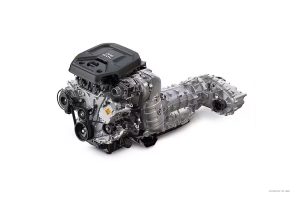Jeep’s 2.0L Turbo engine features in several of its most popular models – like the Wrangler and Grand Cherokee. It’s a fine engine in many ways, but not without its flaws. Now and then, owners might encounter some issues with this particular engine.
Let’s take a look at some examples and see how to fix them by yourself.
Oil Leaks
Let’s begin with one of the most common issues of all – oil leaks. This is when oil spills out from the engine. It’s usually due to weak or faulty gaskets and seals. Fortunately, oil leaks are quite easy to spot – you’ll literally see a pool or oil stain on the ground where you park your car.
To fix this issue, you should first get into the habit of checking your oil on a regular basis. Each week, when the engine is cool, check the dipstick. Pull it out. Wipe off the excess oil. Then put it back into the tube and pull it out again to check the oil level. If the level is low, you’ve probably got a leak.
Next, take a closer look to discover the cause. It might be an old gasket that needs peeling off and replacing. Alternatively, it could be that the oil pan bolts are loose and need tightening up. Another quick fix is to mix some stop leak additive with your engine oil to prevent leaks in the future.
Poor Economy
In general, the 2.0L Turbo Jeep engine is one of the most economic options for the likes of Wranglers and Cherokees. However, you may still notice that your MPG (miles per gallon) isn’t quite as high as you want it to be.
For a quick fix, you may want to switch to a better fuel type. Jeep’s owner’s manuals tend to state that 87-octane should provide “satisfactory” performance for the 2.0 Turbo, but 91+ is better. So, if you’ve been using 87, try switching to 91+ and see how your MPG changes.
Additionally, it’s important to remember that your driving habits also have a direct impact on your engine’s economy. To improve it, drive at a steady speed. Avoid harsh acceleration and sudden breaks. Check and optimize your tire pressure, too, and don’t overload the car with excess weight.
Turbo Lag
Some Jeep 2.0 owners have also complained about turbo lag. This is the phenomenon where you feel a “hesitation” or delay in your vehicle before the turbo kicks in. It’s almost like the car doesn’t respond as quickly as you expect.
For example, you’ll push down on the accelerator, expecting the turbo to fire up and give you a big burst of speed. But that doesn’t happen right away. Instead, it takes a little moment for the turbo to respond.
First up, it’s worth noting that this isn’t necessarily a problem. Pretty much every turbo engine has some degree of lag, especially the 2.0, which isn’t quite as powerful as others. So it’s not necessarily something you can “fix” per se, but you can take steps to improve it.
The most obvious step is to fit a throttle booster or controller. That’ll help you speed up the response times of your engine, minimizing the length of the lag. Look up good boosters for your Jeep and then just follow the manufacturer’s instructions to install one.
Unusual Noises and Vibrations
Popping. Knocking. Grinding. Vibrating. There are a bunch of weird sounds you might also hear coming from your Jeep 2.0 Turbo. Each one has its own potential explanations, so it’s not always easy to know what to do and where to focus when you’re trying to fix them.
A good first step is a visual inspection. Pop the hood and take a close look at the engine. You’re looking for any worn-down belts or clear, visible problems. If any components are obviously damaged, they may need replacing.
Next, check out the air filters. They get clogged and dirty over time, and will eventually need cleaning out or changing. Last but not least, verify the spark plugs, too. Broken or damaged spark plugs can cause all sorts of engine issues, so they’ll need to be replaced as soon as possible.
Car Won’t Start
Here’s the worst-case scenario. You turn the key in the ignition, but your car won’t start. The engine seems to lack power and just refuses to turn over. Again, there are quite a few possible explanations for this. But in the case of the 2.0L Turbo, the ignition switch is one of the most common culprits.
Indeed, many Jeep owners have had to deal with ignition switch problems in their Wranglers and other vehicles. This makes it impossible or at least very difficult to get the car started. Fortunately, you can buy a replacement and fit it yourself, following a video guide or tutorial online to help.
Of course, there may also be other reasons if your engine isn’t starting. In some cases, it might not be something you can fix alone. So, don’t hesitate to contact a trusted pro and ask them to run an engine diagnostic to see what’s wrong.
FAQs
Which Jeeps come with the 2.0 Turbo?
There are several different Jeep models that can come with the 2.0 Turbo engine: the Jeep Wrangler, the Cherokee, the Grand Commander, and the Grand Cherokee. However, most of these vehicles also come with other engine options. The fourth generation Wrangler, for example, can also come with a 3.6L or 6.4L gasoline engine, for instance.
Summing Up
Overall, the 2.0 Turbo is a fine engine with a lot of factors in its favor. You can get many, many miles out of this engine with minimal hassle. But it might not run 100% smoothly, 100% of the time. If you have any issues, try the fixes listed above. If they don’t work, call in the pros and get your engine fixed before hitting the road again.



